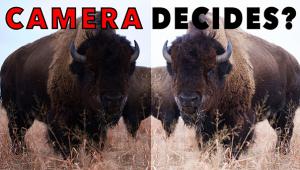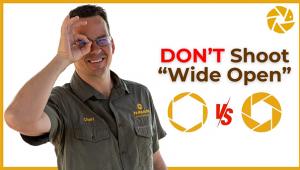How to Get the Most Out of a Photo Safari: Tips for Capturing Wildlife in the Wild

On my recent visit to Africa as a photo tour pro, I decided to capture the beauty and the wildlife of the Serengeti totally mirrorless. Considering my recent move to the format, the trip was confirmation of how committed I am to it, as I took only my mirrorless Nikon Z cameras—three of them, in fact: my Z6, Z7, and the Z7 I had converted to infrared. Yes, I'm all in.
But this isn't a story about hardware. It's about what it's like to photograph on a photo safari, and from my point of view, what it's like to also lead and coach others so we all get the most from the opportunity.
Here's a clue: it's not just photography; it's reactive photography. You learn by shooting, and while there are some things you can control, when wild animals are your subjects, every opportunity to take a picture is a learning experience, and usually a pretty fast one.

On the Trails
We were in Serengeti National Park, in northern Tanzania, for the 11-day photo safari. I had four dedicated photo enthusiasts with me; only one had been to Africa before. We traveled, we shot, we checked results. I'd advise and suggest before and after.
In any crucial and complex situation, my goal—really my job—is to anticipate the questions. A lot of them are along the lines of being prepared: What's the best shutter speed, aperture, lens or focal length for this opportunity? My technical guidance comes from my experience; my creative guidance from the ways I like to shoot and what works for me.

The pace of the tour is...well, call it not exactly leisurely. Most days we left at sunup, came back after sundown, and were on the go the entire time in between. While we catch lunch out in the beauty of the Serengeti, the guests check their images and ask questions.
We go over concepts and techniques because we all want a variety of images—not just different animals, but different looks: scene setters, frame-filling close-ups, action, details—images that when viewed capture as best we can the experience of the journey. I think that was the point of the trip for the guests—basically to experience it. They could apply their photo skills and see how they worked out. And, of course, I'd share the shooting information I thought they'd need as we went along.

There are so many subjects, and so many possible views in the vastness of the Serengeti, that it can be too much. But that's the task, isn't it? To not be overwhelmed; to get a handle on it. And at the end of each day, we see how well we did when we review our images, share favorite shots and tell our stories. Then we prepare for the next day's adventure.

The Wildebeests
Serengeti National Park is known for its massive migration of wildebeests, and they were pretty much Topic A on the trip. On the day we photographed them, our Land Cruiser driver was in communication with other drivers about the animals' location—the drivers are the key to knowing the when, where and how of what's going on—so there was a lot of buildup by the time we got to the wildebeests. Turned out they were fearsome, puzzling, and dorky—seriously—all at the same time.
We first saw them at the edge of a 30-foot cliff as they were jumping down onto rocks and hard ground to approach and then cross the Mara River. Actually, not all were jumping—some were peeling off to find another, presumably safer, path.

But the ones at the top of the cliff would get antsy, and when one would jump, others followed. Behind them, as far as I could see, there were seemingly miles and miles of wildebeests. I'd never seen that many creatures at one time.
In our group, everyone had a different photographic take on the wildebeests, and the end-of-day image viewing was a lot of fun and a lot of learning. One of the photographers had a crop sensor camera and kept the lens zoomed in on them, filling her frames with absolutely stunning images.

Another photographer really wanted to show them crossing the river as a group and have some background in the shot. One guest went global to get the overall scene, the entire environment. Another did some experimenting with shutter speed: what happens if I shoot at 1/60 second to blur the motion?
My idea was, Wow, shoot a video! And do it in slow motion to exaggerate the power of their movements.
Tips and Tools
Earlier I said this wasn't a story of gear, but a quick mention reinforces the idea of readiness on a photo tour like this one.
In addition to the three Z cameras, I brought along the 24-70mm dedicated Z lens and three DSLR lens I could fit to my Z cameras using the FTZ mount adapter: a 70-200mm, a 200-500mm, and my most-creative-fun lens, the 8-15mm zoom fisheye. I also had a 1.4 teleconverter for some extra reach.

As far as tips, it comes down to think fast and be prepared.
The driver knows the route and locations for the best photo opportunities; the tour leader knows the itinerary. But it's a long day, and in the Serengeti, a super-hot and super-dusty one. The dust is prevalent and so fine it gets into and onto everything. There are no roads, just dusty trails, so you really don't want to be changing lenses—well, maybe when the vehicle is stopped—which says a lot for having versatile lenses and more than one camera body.
I tried to keep the cameras and lenses covered, but I had to do a lot of wiping down. As I write this I've just sent everything off to be cleaned at a local place, and I know when I pick it up I'm going to hear, "What did you do?"
I'll probably reply, "Let me tell you about the wildebeests."
Deborah Sandidge's website, deborahsandidge.com, offers a collection of her photographs as well as photo tips and a schedule of upcoming workshops, photo tours, and seminars. She works with Discovery Photo Tours for events like the one in this story.
















































